height MITSUBISHI L200 2013 Owner's Manual (in English)
[x] Cancel search | Manufacturer: MITSUBISHI, Model Year: 2013, Model line: L200, Model: MITSUBISHI L200 2013Pages: 362, PDF Size: 21.07 MB
Page 4 of 362
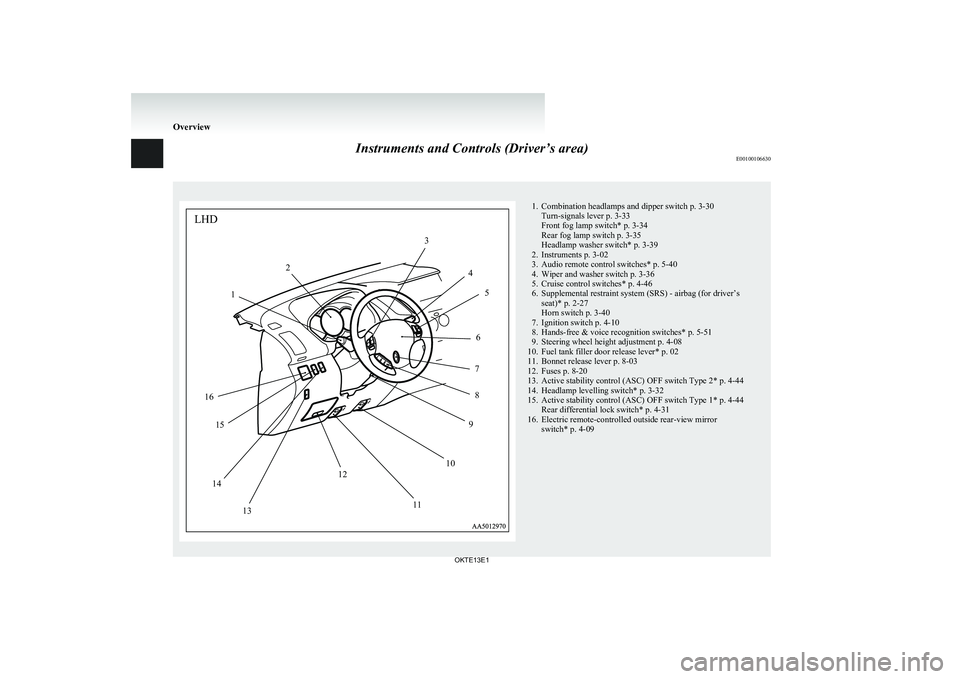
Instruments and Controls (Driver’s area)E00100106630
1LHD23456789101112131415161. Combination headlamps and dipper switch p. 3-30
Turn-signals lever p. 3-33
Front fog lamp switch* p. 3-34
Rear fog lamp switch p. 3-35
Headlamp washer switch* p. 3-39
2. Instruments p. 3-02
3. Audio remote control switches* p. 5-40
4. Wiper and washer switch p. 3-36
5. Cruise control switches* p. 4-46
6. Supplemental restraint system (SRS) - airbag (for driver’s seat)* p. 2-27
Horn switch p. 3-40
7. Ignition switch p. 4-10
8. Hands-free & voice recognition switches* p. 5-51
9. Steering wheel height adjustment p. 4-08
10. Fuel tank filler door release lever* p. 02
11. Bonnet release lever p. 8-03
12. Fuses p. 8-20
13. Active stability control (ASC) OFF switch Type 2* p. 4-44
14. Headlamp levelling switch* p. 3-32
15. Active stability control (ASC) OFF switch Type 1* p. 4-44 Rear differential lock switch* p. 4-31
16. Electric remote-controlled outside rear-view mirror switch* p. 4-09
Overview
OKTE13E1
Page 5 of 362
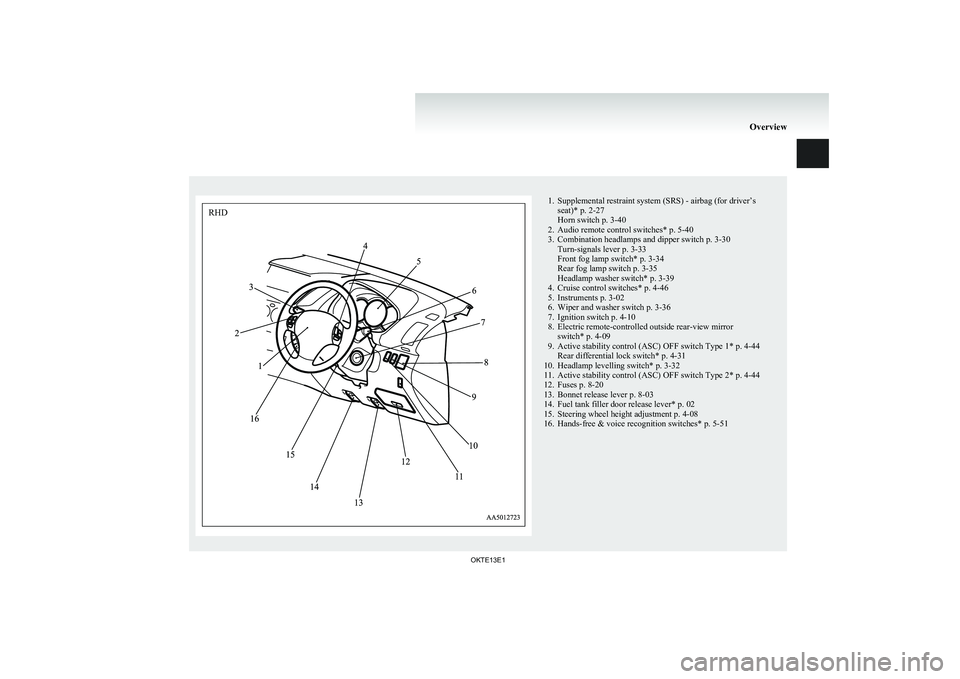
1. Supplemental restraint system (SRS) - airbag (for driver’sseat)* p. 2-27
Horn switch p. 3-40
2. Audio remote control switches* p. 5-40
3. Combination headlamps and dipper switch p. 3-30 Turn-signals lever p. 3-33
Front fog lamp switch* p. 3-34
Rear fog lamp switch p. 3-35
Headlamp washer switch* p. 3-39
4. Cruise control switches* p. 4-46
5. Instruments p. 3-02
6. Wiper and washer switch p. 3-36
7. Ignition switch p. 4-10
8. Electric remote-controlled outside rear-view mirror switch* p. 4-09
9. Active stability control (ASC) OFF switch Type 1* p. 4-44 Rear differential lock switch* p. 4-31
10. Headlamp levelling switch* p. 3-32
11. Active stability control (ASC) OFF switch Type 2* p. 4-44
12. Fuses p. 8-20
13. Bonnet release lever p. 8-03
14. Fuel tank filler door release lever* p. 02
15. Steering wheel height adjustment p. 4-08
16. Hands-free & voice recognition switches* p. 5-51
Overview
OKTE13E1RHD
Page 48 of 362
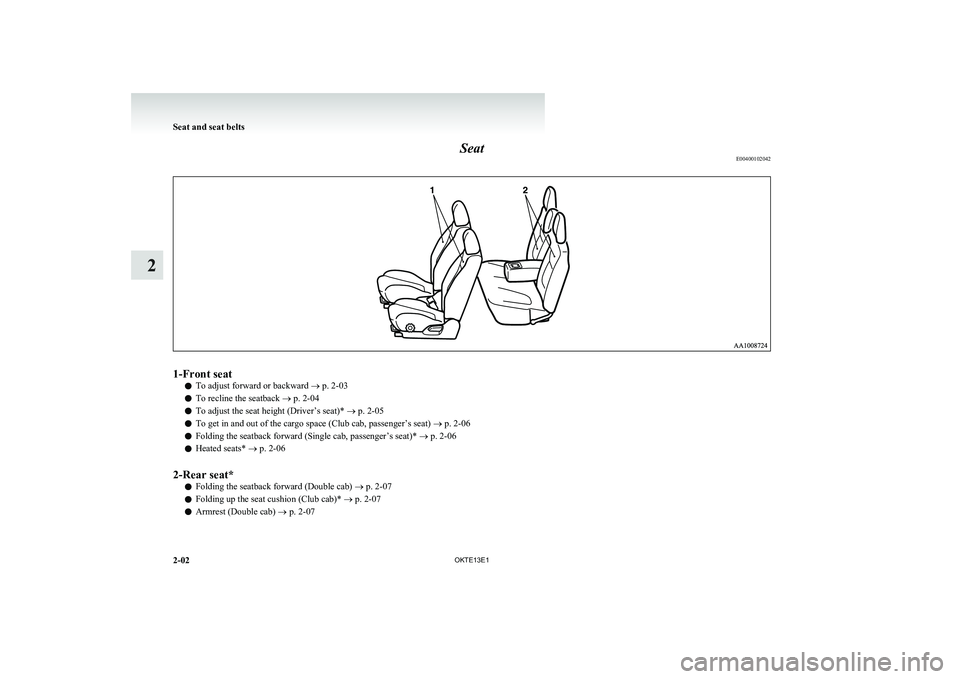
SeatE004001020421-Front seat
lTo adjust forward or backward
® p. 2-03
l To recline the seatback
® p. 2-04
l To adjust the seat height (Driver’s seat)*
® p. 2-05
l To get in and out of the cargo space (Club cab, passenger’s seat)
® p. 2-06
l Folding the seatback forward (Single cab, passenger’s seat)*
® p. 2-06
l Heated seats*
® p. 2-06
2-Rear seat*
l Folding the seatback forward (Double cab)
® p. 2-07
l Folding up the seat cushion (Club cab)*
® p. 2-07
l Armrest (Double cab)
® p. 2-07
Seat and seat belts
2-02 OKTE13E1
2
Page 51 of 362

To adjust the seat height (Driver’s
seat)* E00400701113
Manual type
Dial type
To adjust the seat cushion height, turn the dial as
shown in the illustration.
1- To move the seat cushion up
2- To move the seat cushion down
Lever type
Adjust the seat height by repeatedly operating the
lever.
1- Raise
2- Lower
Power type
To adjust the seat height, operate the switch as indi-
cated by arrows.
NOTE l To prevent the battery from running down,
operate the power type seat with the engine
running.
1- To move the front of the seat up and down
2- To move the rear of the seat up and down
Seat and seat belts
2-05
OKTE13E1
2
Page 53 of 362
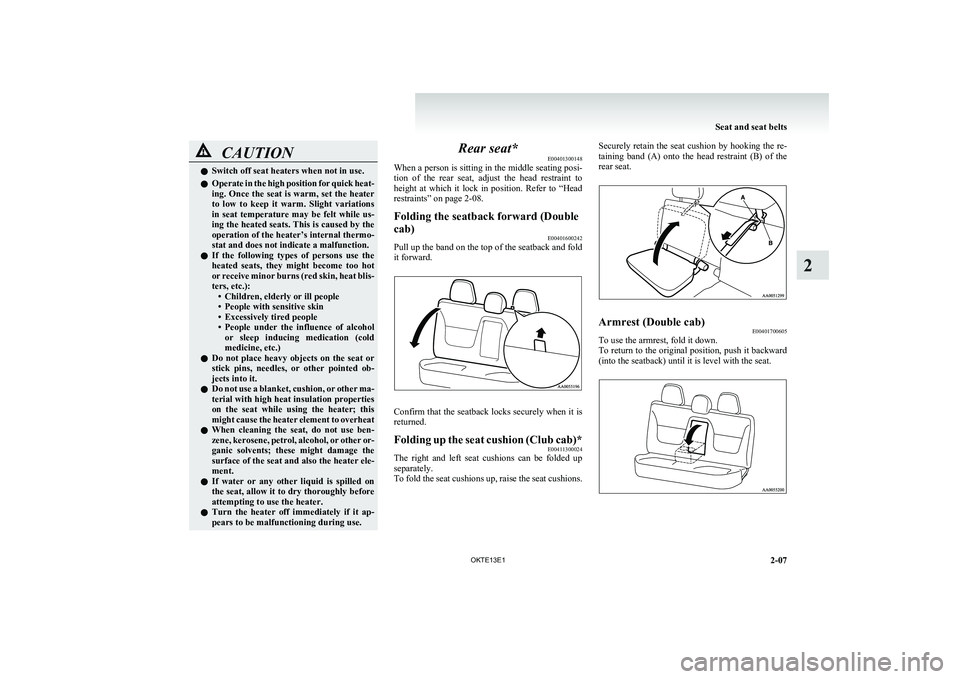
CAUTIONlSwitch off seat heaters when not in use.
l Operate in the high position for quick heat-
ing. Once the seat is warm, set the heater
to low to keep it warm. Slight variations
in seat temperature may be felt while us-
ing the heated seats. This is caused by the
operation of the heater’s internal thermo-
stat and does not indicate a malfunction.
l If the following types of persons use the
heated seats, they might become too hot
or receive minor burns (red skin, heat blis-
ters, etc.): • Children, elderly or ill people
• People with sensitive skin
• Excessively tired people
• People under the influence of alcohol
or sleep inducing medication (cold
medicine, etc.)
l Do not place heavy objects on the seat or
stick pins, needles, or other pointed ob-
jects into it.
l Do not use a blanket, cushion, or other ma-
terial with high heat insulation properties
on the seat while using the heater; this
might cause the heater element to overheat
l When cleaning the seat, do not use ben-
zene, kerosene, petrol, alcohol, or other or-
ganic solvents; these might damage the
surface of the seat and also the heater ele-
ment.
l If water or any other liquid is spilled on
the seat, allow it to dry thoroughly before
attempting to use the heater.
l Turn the heater off immediately if it ap-
pears to be malfunctioning during use.Rear seat* E00401300148
When a person is sitting in the middle seating posi-
tion of the rear seat, adjust the head restraint to
height at which it lock in position. Refer to “Head
restraints” on page 2-08.Folding the seatback forward (Double
cab) E00401600242
Pull up the band on the top of the seatback and fold
it forward.
Confirm that the seatback locks securely when it is
returned.
Folding up the seat cushion (Club cab)* E00411300024
The right and left seat cushions can be folded up
separately.
To fold the seat cushions up, raise the seat cushions.
Securely retain the seat cushion by hooking the re-
taining band (A) onto the head restraint (B) of the
rear seat.Armrest (Double cab) E00401700605
To use the armrest, fold it down.
To return to the original position, push it backward
(into the seatback) until it is level with the seat.
Seat and seat belts
2-07
OKTE13E1
2
Page 54 of 362
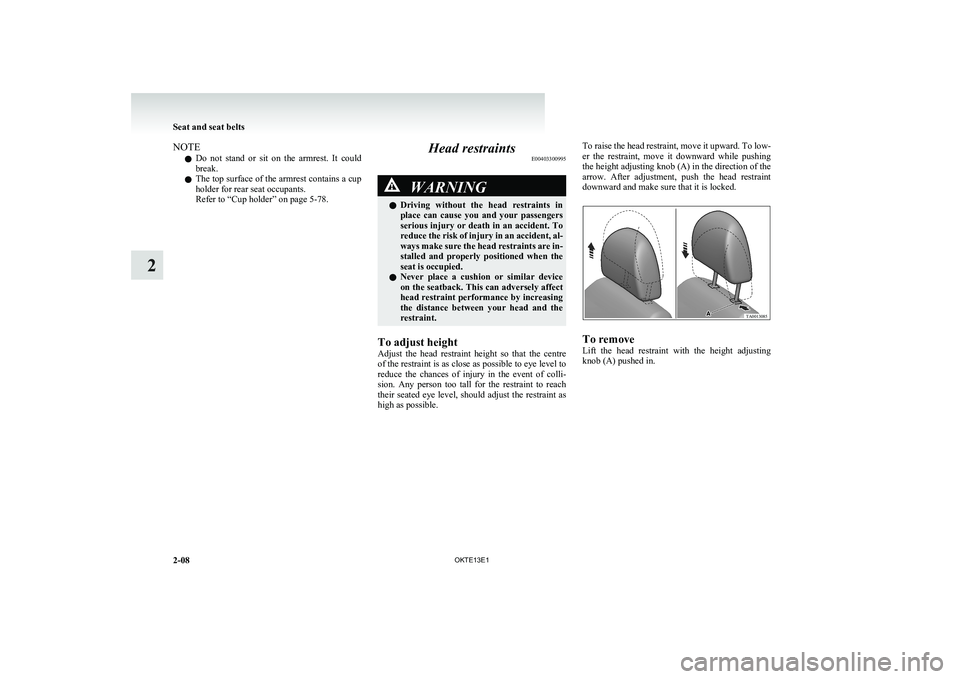
NOTEl Do not stand or sit on the armrest. It could
break.
l The top surface of the armrest contains a cup
holder for rear seat occupants.
Refer to “Cup holder” on page 5-78.Head restraints E00403300995WARNINGlDriving without the head restraints in
place can cause you and your passengers
serious injury or death in an accident. To
reduce the risk of injury in an accident, al-
ways make sure the head restraints are in-
stalled and properly positioned when the
seat is occupied.
l Never place a cushion or similar device
on the seatback. This can adversely affect
head restraint performance by increasing
the distance between your head and the
restraint.
To adjust height
Adjust the head restraint height so that the centre
of the restraint is as close as possible to eye level to
reduce the chances of injury in the event of colli-
sion. Any person too tall for the restraint to reach
their seated eye level, should adjust the restraint as
high as possible.
To raise the head restraint, move it upward. To low-
er the restraint, move it downward while pushing
the height adjusting knob (A) in the direction of the
arrow. After adjustment, push the head restraint
downward and make sure that it is locked.
To remove
Lift the head restraint with the height adjusting
knob (A) pushed in.
Seat and seat belts
2-08 OKTE13E1
2 TA0013085
Page 55 of 362

To install
Confirm that the head restraint is facing the correct
direction, and then insert it into the seatback while
pressing the height adjusting knob (A) in the direc-
tion indicated by the arrow.CAUTIONl Confirm that the height adjusting knob
(A) is correctly adjusted as shown in the
illustration, and also lift the head re-
straints to ensure that they do not come
out of the seatback.CAUTIONl If your vehicle is equipped with the rear
seat head restraint, the head restraints
for the front and rear seats differ in size.
When installing head restraints, make
sure the front and rear head restraints
are fitted in their respective seats.Seat belts E00404800825
To protect you and your passengers in the event of
an accident, it is most important that the seat belts
are worn correctly while driving.
A seat belt for a front seat equipped with an airbag
has a pretensioner system. These belts are used the
same way as a conventional seat belt.
Refer to “Seat belt pretensioner system and force
limiter system” on page 2-12 .WARNINGl Always place the shoulder belt over your
shoulder and across your chest. Never
put it behind you or under your arm.
l One seat belt should be used by only one
person. Doing otherwise can be dangerous.
l The seat belt will provide its wearer with
maximum protection if the recliner seat-
back is placed in fully upright position.
When the seatback is reclined, there is
greater risk that the passenger will slide
under the belt, especially in a forward im-
pact accident, and may be injured by the
belt or by striking the instrument panel
or seatbacks.
l Seat belts should always be worn by ev-
ery adult who drives or rides in this vehi-
cle, and by all children who are tall
enough to wear seat belts properly.
l Remove any twists when using the belt.
Seat and seat belts
2-09
OKTE13E1
2TA0013098
Page 57 of 362

Seat belt reminder/warning lampE00409800790
A tone and warning lamp are used to remind the
driver and front passenger to fasten the seat belt.
NOTE l For the front passenger seat, the warning func-
tion works only while a person is sitting on
the seat.
When the ignition key is turned to the “ON” posi-
tion, the warning lamp will come on and a tone
will sound for about 6 seconds. If the front seat belt
remains unfastened approximately 1 minute later,
the warning lamp will flash and the tone sound in-
termittently (each 12 times) when the vehicle is driv-
en. If the passenger subsequently unfastens the seat
belt while driving, the warning lamp and tone will
issue further warnings. And if the seat belt remains
unfastened, the warning lamp and tone will issue
further warnings each time the vehicle starts mov-
ing from a stop. When the seat belt is fastened, the
warnings will stop.
WARNINGl In order to reduce the risk of serious or fa-
tal injury in an accident, always wear
your own seat belt. Do not allow anyone
to ride in your vehicle unless he or she is
also seated and wearing a seat belt. Chil-
dren should additionally be restrained in
a secure child restraint system.
NOTE
l When luggage is placed on the front passen-
ger seat, a sensor in the seat cushion may, de-
pending on the weight and position of the lug-
gage, cause the warning tone to sound and
the warning lamp to come on (Double cab).
Adjustable seat belt anchor (front
seats)* E00405000299
The seat belt anchor height can be adjusted.
Move the seat belt anchor down with the lock knob
(A) depressed. To move the anchor up, slide it with-
out depressing the lock knob (A).
Anchor downAnchor up
WARNINGl When adjusting the seat belt anchor, set
it at a position that is sufficiently high so
that the belt will make full contact with
your shoulder but will not touch your neck.Lap belts* E00405100128
The lap belts should be adjusted by holding the belt
and latch plate at right angles to each other, and
then pulling the belt as shown in the illustration to
a snug fit around the occupant.
1- Tighten
2- Loosen
While holding the latch plate, insert the latch plate
into the buckle until a “click” is heard.
Seat and seat belts
2-11
OKTE13E1
2
Page 60 of 362

Front passenger’s airbag ON
NOTEl If you have a rearward facing child restraint
system that cannot be fitted to any seat other
than the front passenger seat, be sure to turn
OFF the front passenger’s airbag ON-OFF
switch before using it. (Refer to “To turn an
airbag off” on page 2-31.)
Front passenger’s airbag OFF
WARNINGl A FORWARD FACING CHILD RE-
STRAINT should not be used in the front
passenger seat whenever possible; if used
in the front passenger seat, adjust the
seat to the most rearward position.Infants and small children E00406600768
When transporting infants and small children in
your vehicle, follow the instruction given below.
Instruction:
l For small infants, an infant carrier should be
used. For small children whose height when
seated allows the shoulder belt to lie in con-
tact with the face or the throat, a child seat
should be used.
l The child restraint system should be appropri-
ate for the child’s weight and height and prop-
erly fit in the vehicle.
l Before purchasing a child restraint system,
try installing it in the seat to make sure there
is a good fit. Because of the location of the
seat belt buckles and the shape of the seat
cushion, it may be difficult to securely install
some manufacturer’s child restraint systems.
If the child restraint system can be pulled for-
ward or to either side easily on the seat cush-
ion after the seat belt has been tightened,
choose another manufacturer’s child restraint
system.WARNINGl When installing a child restraint system,
refer to the instructions provided by the
manufacturer of the restraint system. Fail-
ure to do so can result in severe or fatal
injury to the child.
l After installation, push and pull the child
restraint system back and forth, and side
to side, to see that it is properly secured.
If the child restraint system is not instal-
led securely, it may cause injury to the
child or other occupants in the case of ac-
cident or sudden stops.
Seat and seat belts
2-14 OKTE13E1
2
Page 62 of 362

Suitability for various ISOFIX positionsE00411400517Mass groupSize classFixtureVehicle ISOFIX positionsRear Outboard (Double cab)CarrycotFISO/L1XGISO/L2X0- Up to 10 kgEISO/R1X0+- Up to 13 kgEISO/R1IL*1
, IL* 2DISO/R2XCISO/R3XI-9 to 18 kgDISO/R2XCISO/R3XBISO/F2IUFB1ISO/F2XIUF, IL* 3AISO/F3IUFII-15 to 25 kg XIII-22 to 36 kg XCAUTIONl
When installing a child restraint system, prevent the head restraint from touching the child restraint system by removing it or adjusting its height.Key of letters to be inserted in the table above:
lIUF- Suitable for ISOFIX forward child restraints systems of universal category approved for use in the mass group.
l IL- Suitable for particular ISOFIX child restraint systems given in the following list (MITSUBISHI MOTORS genuine parts).
l X- ISOFIX position not suitable for ISOFIX child restraint systems in this mass group and/or this size class.
Seat and seat belts
2-16
OKTE13E1
2